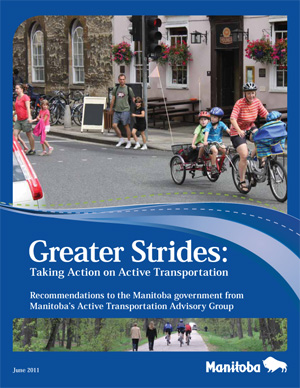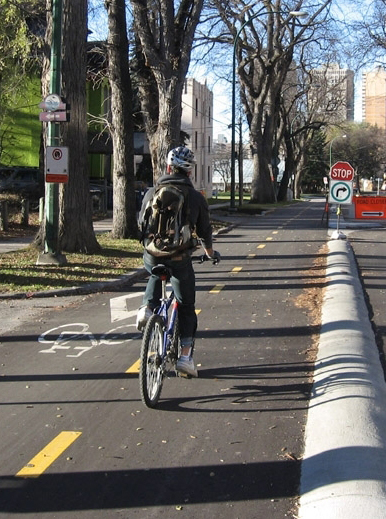Healthy and sustainable communities require planning and infrastructure to support walking and cycling. If the October 4th general election is about building the kind of province we would like to develop over the next four years, active transportation should be at the top of voters’ minds and candidates’ platforms.
Back in 2009, a handful of individuals were asked to be part of a Manitoba Active Transportation Advisory Group. (See news release) They were tasked with providing recommendations on how to get more Manitobans walking and cycling in communities across our province.
The timing of the release of their report, Greater Strides: Taking Action on Active Transportation, at the end of June 2011 couldn’t have come at a better or a worse time. Better because there is a provincial election on October 4th, which allows each of us to ask commitments from the candidates in our constituency. Worse because it meant the report could not be released widely due to election restrictions and as a result did not get much media or public attention.
When provincial candidates knock on my door this September, here are the key commitments I will be asking from them:
1. Establish a Provincial Active Transportation Policy
- A written policy on active transportation clearly states Manitoba’s commitment to walking and cycling.
- Such policy provides direction, guidance and sets the foundation to integrate active transportation in strategic funding decisions throughout the province.
- It helps avoid current examples of large investments of public funding into massive infrastructure projects that, to date, continue to ignore active transportation, such as the impact of CentrePort on existing and future walking and cycling routes and the Winnipeg to Birds Hill interchange project.
- See recommendations #1 & #13 in Greater Strides.
2. Establish a Director of Transportation with staff responsible for improving active transportation
- There are over 3000 staff in government developing motorized vehicle transportation routes and infrastructure, but not one staff person solely responsible for improving walking and cycling in our communities and across the province.
- See recommendation #2 in Greater Strides.
3. Maintain public input through a Provincial Active Transportation Advisory Board
- An Advisory Board brings together representatives from community organizations and provincial departments to share learning opportunities and valuable information.
- It assists in ensuring the integration of transportation planning and programs throughout the province.
- The City of Winnipeg has made significant progress in the development of active transportation due in large part to the guidance of its Active Transportation Advisory Committee.
- See recommendation #24 in Greater Strides.
4. Develop routes so CHILDREN can SAFELY walk and bike to school
- Virtually every school division in Manitoba has a transportation planner focused on busing children to school and yet there is not one staff person dedicated to ensuring children can safely walk or bike to school.
- 31% of Manitoba children are overweight or obese, higher than the national average.
- See recommendation #21 in Greater Strides.
5. Educate ALL road users on how to safely share & use the roadway system
- Manitoba’s driver training programs do not cover educating motorists and cyclists on how to share the road, and there are no provincial bicycle skills training programs for children or adults.
- See recommendations #20 & #22 in Greater Strides.




Recent Comments